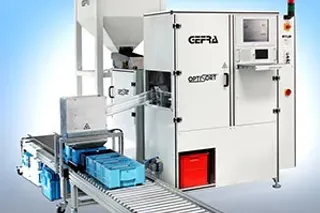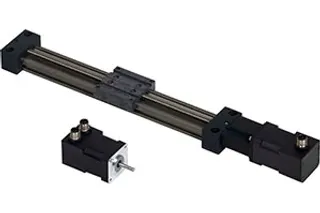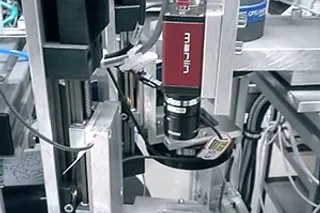Change Language :
Examinees put in the right light
drylin®®-linear axis in high-speed inspection systems
Visual inspection of small components in very high quantities: Gefra GmbH in Friedewald/Westerwald has set itself the task of automating this task - and is successful with it worldwide. Gefra uses complete linear drive units from the drylin® programme from igus® for the electrical adjustment of the lighting units.
How do you inspect 900 screws or 700 injection moulded parts per minute for damage? anyone asking themselves this question will find the right answer at Gefra GmbH, a company founded in 1995 that specialises in developing automated systems for the fast and precise optical inspection and measurement of components.
The reason for founding the company was the realisation that there was a need in this area. Dipl.-Thomas Rothweiler, founder and managing partner of the company, advised production companies on rationalisation and automation. In doing so, he realised that at the end of highly automated processes, goods are often still checked with the human eye and sorted manually.

The modular Optisort systems inspect small parts such as screws, seals and injection moulded components.
Automated testing at high speed
The Optisort machines that he subsequently developed use camera technology in conjunction with automated feeding and very fast computer systems, and the speed is impressive when you see one of these systems in action: the test specimens are fed individually from a bunker system via a vibratory conveyor, in the correct position if required, and passed to the cameras either on a glass plate, a special metal plate for screws or a conveyor belt. 360° inspections with four cameras are also possible. Good parts are actively ejected, faulty parts are separated.
All of this happens at a speed that the human eye can barely keep up with. "The systems inspect several hundred parts per minute, in some cases more than 50,000 pieces per hour," says Thomas Rothweiler. They are very flexible because they inspect different components: "Each machine typically inspects 200 to 300 products." A separate inspection programme is created for each product.
Mechanics and computing speed set technical limits
With the continuous further development of the systems, the mechanics, i.e. feeding at such a high speed, have always reached their limits in the past. In some cases, however, the computing speed of the available control systems also reached its limit, which is also obvious when you consider that in some cases eight or ten cameras inspect the test specimen and the control system has to decide whether it is "good" or "not OK" within milliseconds.
Electrical adjustment of the lighting
Even though each machine is customised to the customer's requirements, Thomas Rothweiler emphasises that this is not a case of custom machine construction: "Our machines are based on a modular principle and we use many identical parts."
A current further development concerns the lighting, which is used to put the test specimens in the right light for the cameras. The distance between the lights and the test specimen varies depending on the product, and the user adjusts the lights manually using a dial with a scale. Thomas Rothweiler's aim was to integrate this process into the control system and thus make it reproducible. This was not only intended to save manual process steps and eliminate the possibility of incorrect settings. Even more important was the ability to integrate the position of the lights into the documentation.

Everything from a single source: In the drylin® E-units, the carriage and stepper motor are combined into a ready-to-connect unit.
Complete linear drive unit as a solution
In their search for suitable linear drives, the Gefra engineers found what they were looking for in thedrylin® programme from igus®. Based on the drylin®-linear axis, in which a slide from the high-performance polymer iglidur® moves with the help of a drive spindle, igus® developed the drylin® E-programme. (E for electric). These are complete linear drive units in which a stepper motor drives the axis via an optional flange and an optional claw coupling.
With this axis, Gefra has created the prerequisite for integrating the luminaire adjustment into the PC control system and thus into the respective test plan, taking automation one step further. An axis with 60 mm stroke is used, which is driven by a NEMA 17 stepper motor and moves loads of up to 1000 g with an accuracy of +/- 0.5 mm.
Lubricant-free operation
Lubricant-free operation of the spindle and carriage was a crucial criterion in the selection process: As the lighting units are located directly above, next to and below the objects to be inspected in the system's working area, the drives must not emit any foreign substances that could impair the inspection process.
The compact nature of the drive units was equally important. Thomas Rothweiler: "As we will be offering electric adjustment as an option in future, it must be possible to integrate it into the existing design. It is also important to us that we obtain the entire unit with motor, carriage and mounting ready for installation from a single source."

The drylin® linear unit in its installed state
Optisort also at igus®
The new concept has already been trialled in a system that tests seals. Four spindle linear tables of the type drylin® SAW-0630 with electric drive, motor flange and integrated claw coupling are connected to the system's PC via controllers, and the drives fit perfectly into the environment.
Incidentally, the advantages of the Optisort systems are highly appreciated at igus®. A total of four Gefra systems are used to test plain bearings in the Cologne production facility. These are mainly safety-relevant components that igus® manufactures for the automotive industry and which are 100 per cent tested. igus® is currently planning the purchase of a fifth Optisort system, and if those responsible select the option of electric lighting adjustment, some of the drylin® E units delivered to Friedewald will return to their place of production.
Here you can find the products used
You can find more interesting applications from a wide range of areas here
To the manus® competition
Contact us
Contact details
igus® UK01604 677240Submit form
Opening hours
Office hours
Monday to Friday from 8 am - 8 pm.
Live chat:
24h

